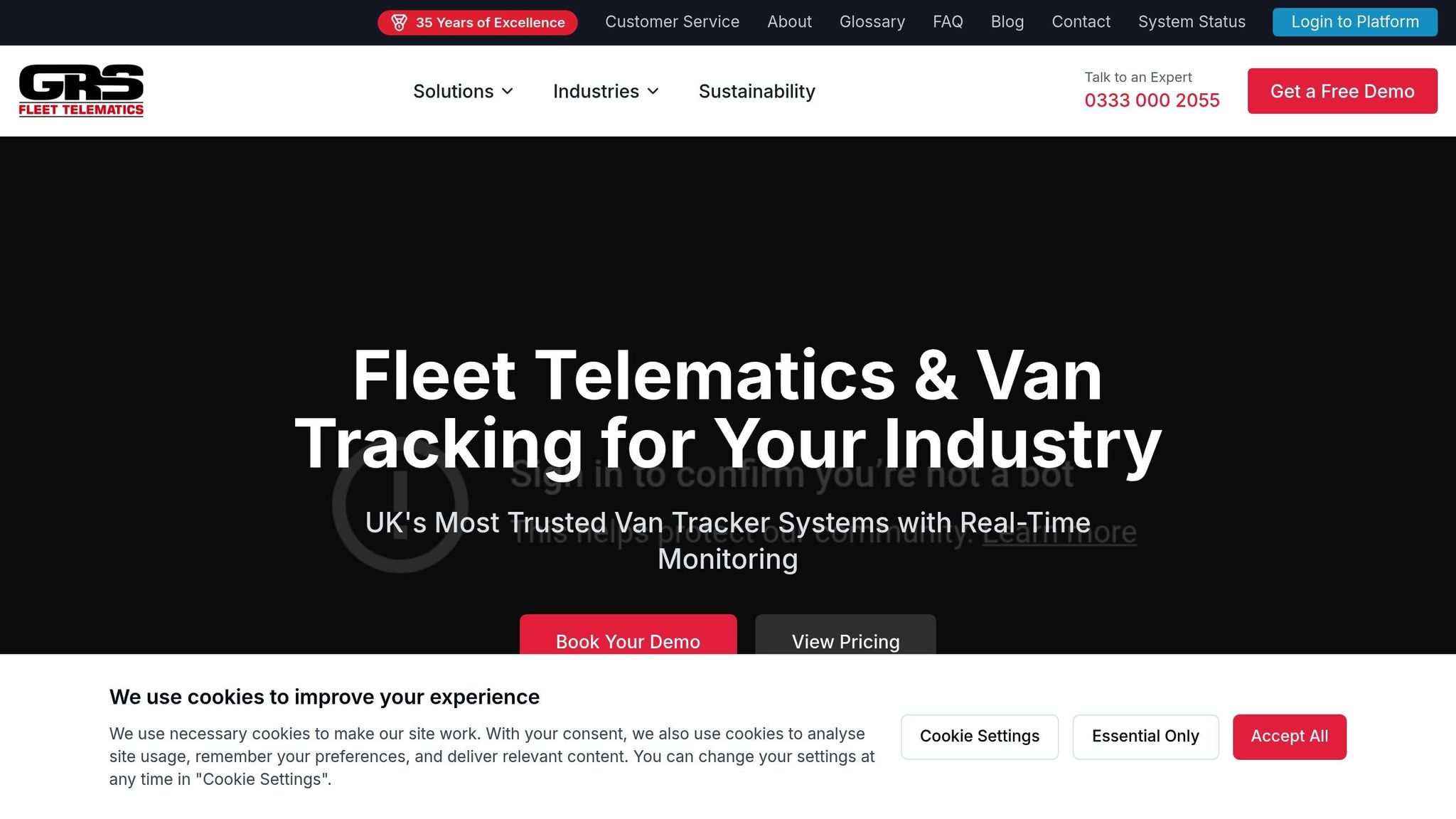Best Practices for Stolen Vehicle Recovery
Explore effective strategies for stolen vehicle recovery, focusing on advanced tracking, layered security, and 24/7 monitoring to protect your fleet.

Vehicle theft is a growing challenge for UK businesses, especially for fleet operators managing high-value vehicles and cargo. Criminals are now using advanced technology like GPS jammers and key cloning, making traditional security measures less effective. This has led to increased costs, disrupted operations, and higher insurance premiums.
To improve recovery rates and minimise losses, fleet operators need to focus on:
- Real-time tracking: Systems with dual-trackers and alerts can counteract GPS jamming and help locate stolen vehicles quickly.
- Layered security: Combining tracking, advanced immobilisers, and physical deterrents makes vehicles harder to steal.
- 24/7 monitoring: Professional services ensure immediate response and coordination with law enforcement.
- Remote immobilisation: Disabling stolen vehicles remotely (with police approval) can prevent further movement.
For example, GRS Fleet Telematics offers solutions like dual-tracker systems, starting at £7.99 per month, with a recovery rate of 91%. Their tools, combined with professional monitoring, help businesses reduce theft risks and recover vehicles efficiently.
Investing in these measures not only protects assets but also ensures smoother operations and lower long-term costs.
What Is Stolen Vehicle Recovery (SVR)? - Talking Tech Trends
What You Need for Successful Vehicle Recovery
Effective vehicle recovery relies on having the right systems in place from the start. Recent data highlights the scale of the issue, showing just how important it is for fleet operators to adopt strategies that go beyond basic security. These strategies form the backbone of swift action and successful recovery.
Real-Time Tracking and Quick Response
When it comes to recovering stolen vehicles, time is critical. The first few hours are often the most important, as thieves tend to move quickly to avoid detection. Real-time tracking systems offer immediate location updates, enabling authorities to act quickly while the trail is still fresh.
Modern tracking systems are designed to counteract advanced criminal tactics. Dual-tracker technology, for example, is highly effective against signal jamming. By combining a primary Thatcham-approved S5 tracker with a hidden backup tracker, fleet operators create redundancy that’s tough for thieves to bypass. Automatic Driver Recognition (ADR) adds an extra layer of security by distinguishing authorised users from unauthorised ones, triggering alerts if someone attempts to start the vehicle without approval.
Some advanced systems even allow for remote immobilisation, though this feature requires police authorisation and professional oversight. Around-the-clock professional monitoring further enhances recovery efforts by coordinating with law enforcement as soon as an alert is triggered.
Multiple Security Layers
A single security measure is no match for today’s sophisticated criminals. Techniques like relay attacks on keyless entry, key cloning via OBD ports, and GPS jamming require a more robust approach. A layered security strategy makes vehicles harder to steal and significantly improves the chances of recovery.
The best strategies include three main components: advanced immobilisers, tracking systems, and physical deterrents. Take advanced immobilisers like the Ghost II system, for instance. These devices require a unique PIN to be entered using the vehicle’s existing controls, making them resistant to relay attacks and key cloning. Unlike standard factory immobilisers, these systems are specifically designed to avoid being bypassed through the OBD port.
Physical deterrents also remain valuable. A sturdy steering wheel lock, for example, can slow down thieves and make your vehicle a less attractive target.
Insurance companies are increasingly recognising the value of layered security. Many now insist on Thatcham-approved trackers or immobilisers for high-value vehicles. For example, Heritage Insurance reported that Range Rover owners could face premiums of over £14,000 annually without proper security measures. However, adding these devices can make insurance far more affordable.
UK Vehicle Recovery Legal Requirements
Fleet operators must also navigate the legal landscape surrounding vehicle recovery. Statutory recovery fees limit the costs involved, but these can still add up for fleets with multiple vehicles.
Once a stolen vehicle is recovered, there are specific steps to follow. These include preserving evidence, completing insurance assessments, and preparing the vehicle for return to service. In some cases, recovered vehicles tied to criminal investigations may be held for longer periods, affecting fleet availability and requiring temporary replacements.
Data protection is another key consideration. Tracking systems must comply with UK GDPR regulations, particularly regarding employee privacy and data management. Many professional tracking providers build compliance into their services, easing the burden on fleet operators.
Working with police-approved recovery services ensures that all procedures meet law enforcement standards. These services are familiar with the evidence requirements needed for prosecutions and can liaise effectively with investigators, all while protecting the interests of fleet operators.
Proven Methods to Improve Recovery Rates
When it comes to vehicle recovery, having the right tools and systems in place can make all the difference. While robust security measures lay the groundwork, the following methods take recovery efforts to the next level. High recovery rates hinge on a combination of advanced technology and round-the-clock support.
Using Advanced Telematics Solutions
Advanced telematics systems provide powerful tracking capabilities that go beyond basic GPS. One standout feature is geo-fencing, which allows you to set virtual boundaries around specific areas. If a vehicle crosses these boundaries during restricted times, an alert is triggered, enabling quick action.
To ensure uninterrupted tracking, dual-tracker systems are often employed. These systems keep monitoring active even if one device is tampered with. Additionally, instant notifications ensure fleet managers can alert authorities immediately when a theft occurs, improving the chances of recovery.
Working with 24/7 Recovery Services
Around-the-clock recovery support is a cornerstone of effective vehicle recovery. Monitoring centres staffed 24/7 play a vital role by verifying alerts before escalating them to authorities. This ensures that only confirmed incidents receive attention, avoiding unnecessary delays. By keeping fleet operators updated throughout the process, these services work hand-in-hand with telematics to provide comprehensive protection.
Remote Vehicle Immobilisation
Remote immobilisation technology adds another layer of security. This feature allows authorised personnel to disable a stolen vehicle remotely, preventing it from being moved to a harder-to-recover location. When used in compliance with legal regulations, this capability can stop a theft in its tracks. Modern systems even offer options like disabling engine restarts, giving operators more control over the situation.
How GRS Fleet Telematics Enhances Recovery Rates

GRS Fleet Telematics showcases how these methods come together for maximum effectiveness. Their dual-tracker technology, combined with 24/7 monitoring and remote immobilisation features, has contributed to an impressive 91% recovery rate. This highlights how combining advanced tools with expert support creates a seamless and effective recovery system, ensuring fleets stay protected.
How GRS Fleet Telematics Helps Recover Stolen Vehicles
GRS Fleet Telematics combines effective recovery strategies with a practical solution tailored for UK fleets.
Impressive Recovery Rates and Reliable Technology
With a 91% recovery rate for stolen vehicles, GRS Fleet Telematics delivers dependable results. Its dual-tracker system ensures continuous monitoring, even if one device is tampered with or disabled. This layered approach significantly boosts recovery success.
Pricing is straightforward and affordable, starting at just £7.99 per vehicle per month. This fee includes SIM, data, account management, and full access to the platform, making professional-grade security accessible to businesses of all sizes.
For hardware, there are options to suit different budgets and security requirements:
- Essential package (£35): Single wired tracker for basic protection.
- Enhanced package (£79): Dual-tracker system for improved security.
- Ultimate package (£99): Includes remote immobilisation for maximum control.
Tailored Plans for Every Fleet
The three-tier system ensures flexibility, catering to fleets of all sizes and risk levels. For instance, a small delivery company might find the Essential package sufficient, while a construction firm managing expensive equipment could benefit from the immobilisation feature in the Ultimate package.
The pay-per-recovery model is another highlight, as businesses only pay recovery fees when a vehicle is retrieved. When combined with GRS Fleet Graphics for branding, installation is included at no extra charge, offering even more value.
Around-the-Clock Support and Scalable Solutions
GRS Fleet Telematics backs its hardware with 24/7 support, ensuring swift action when incidents occur. Alerts are verified and escalated to law enforcement without delay, reducing response times.
The service also offers a white-label branding option, enabling businesses to present the tracking solution under their own name. A dedicated account manager supports ongoing needs, from optimising the system to monitoring driver safety and improving operational efficiency. Whether managing a handful of vehicles or a larger fleet, businesses can rely on this scalable solution without needing complicated adjustments.
Conclusion: Protecting Your Fleet with Proven Methods
Vehicle theft remains a persistent challenge for UK businesses, but the right mix of technology, compliance, and recovery strategies can make a real difference. By combining advanced telematics with layered security measures, businesses can significantly enhance both theft prevention and recovery success rates.
Technological advancements offer tools that are essential for effective recovery. Features like remote immobilisation and dual-tracker systems make it incredibly difficult for even the most skilled thieves to disable monitoring systems. When paired with immediate response protocols and 24/7 monitoring services, these technologies create a robust defence against theft.
Legal compliance plays a key role in recovery efficiency. Ensuring that your fleet has proper documentation, up-to-date vehicle records, and a clear understanding of recovery obligations can prevent delays and improve the chances of retrieving stolen vehicles. Given the financial strain caused by theft - through disruptions, increased insurance premiums, and replacement costs - investing in strong recovery methods is more of a necessity than an option.
Fleet operators who prioritise comprehensive tracking systems often experience lower theft rates and quicker recoveries when incidents occur. For instance, GRS Fleet Telematics demonstrates the effectiveness of these strategies. With a 91% recovery rate and security plans starting at just £7.99 per month, they show that professional-grade vehicle protection can be both accessible and cost-effective. Their dual-tracker technology and round-the-clock support directly address the hurdles that often hinder successful recoveries.
The success of GRS Fleet Telematics highlights the importance of adopting a holistic approach. Combining real-time tracking, layered security, and 24/7 professional support creates a system that not only deters theft but also ensures efficient recovery. For fleet operators, this approach is key to protecting their assets and maintaining business continuity.
Investing in proven telematics solutions is a practical choice. The cost of these systems is typically far lower than the financial impact of losing even a single vehicle, making it a sound decision for any business aiming to safeguard its fleet.
FAQs
How do dual-tracker systems enhance the recovery of stolen vehicles compared to traditional methods?
Dual-tracker systems combine GPS tracking with another technology, like radio signals or cellular networks, to improve the chances of recovering stolen vehicles. This two-layered setup means that if one system is compromised, the other can still provide accurate location data.
These systems are equipped with real-time alerts and continuous monitoring, which allow for quicker responses and precise tracking. They’re particularly useful in tricky scenarios, such as cross-border theft, where standard trackers might fall short. With recovery rates reaching up to 91%, dual-tracker systems provide vehicle owners and businesses with greater reassurance and a much better chance of retrieving stolen vehicles swiftly.
What are the rules for remotely immobilising a stolen vehicle in the UK, and how can fleet operators stay compliant?
In the UK, authorities like the police or other designated bodies can authorise the remote immobilisation of a stolen vehicle, particularly in cases involving theft or serious crimes. However, this process must strictly adhere to legal protocols.
Fleet operators need to ensure that any immobilisation systems they use are legally approved and comply with government regulations. This includes keeping accurate documentation, ensuring devices meet the required standards, and only activating immobilisation when explicitly authorised. Following these steps not only helps avoid penalties but also ensures operations remain within the bounds of the law.
Why should fleet operators use a layered security approach, and what does it involve?
A layered security approach is crucial for fleet operators aiming to safeguard vehicles against theft while increasing the chances of recovery. By combining different security measures, this method works to discourage criminals, slow down theft attempts, and enhance detection efforts.
Here are the key elements of a layered strategy:
- Physical security: Tools like steering wheel locks and immobilisers act as visible deterrents and make theft more challenging.
- Electronic tracking: GPS trackers provide real-time monitoring, making it easier to locate vehicles quickly if stolen.
- Operational procedures: Practices such as secure parking and driver training on theft prevention add an extra layer of protection.
This multi-faceted approach helps keep your fleet secure, minimising risks and reducing potential losses.
